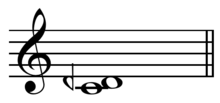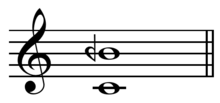
In music theory, a neutral interval is an interval that is neither a major nor minor, but instead in between. For example, in equal temperament, a major third is 400 cents, a minor third is 300 cents, and a neutral third is 350 cents. A neutral interval inverts to a neutral interval. For example, the inverse of a neutral third is a neutral sixth.
Roughly, neutral intervals are a quarter tone sharp from minor intervals and a quarter tone flat from major intervals. In just intonation, as well as in tunings such as 31-ET, 41-ET, or 72-ET, which more closely approximate just intonation, the intervals are closer together.
| minor | neutral | major | |
|---|---|---|---|
| seconds | D♭ | ≊ D |
D♮ |
| thirds | E♭ | ≊ E |
E♮ |
| sixths | A♭ | ≊ A |
A♮ |
| sevenths | B♭ | ≊ B |
B♮ |
Second
Musical interval| Inverse | neutral seventh |
|---|---|
| Name | |
| Abbreviation | n2 |
| Size | |
| Semitones | ~1+1⁄2 |
| Interval class | ~1+1⁄2 |
| Just interval | 11:10 or 12:11 |
| Cents | |
| 12-Tone equal temperament | 100 or 200 |
| 24-Tone equal temperament | 150 |
| Just intonation | 165 or 151 |

A neutral second or medium second is an interval wider than a minor second and narrower than a major second. Three distinct intervals may be termed neutral seconds:
- The intermediate neutral second, called the lesser undecimal neutral second play, has a ratio between the higher-frequency tone to the lower-frequency tone of 12:11 and is about 150.64 cents wide, while the larger one,
- the greater undecimal neutral second play, has a ratio of 11:10 between the two tones and is about 165.00 cents wide. The lesser undecimal neutral second may be derived from the harmonic series as the interval between the eleventh and twelfth harmonics. The greater undecimal neutral second may be derived from the harmonic series as the interval between the tenth and eleventh harmonics.
- An equal-tempered neutral second play is characterized by a difference in 150 cents between the two tones, a hair smaller than a ratio of frequencies between the two tones of 12:11, and exactly half of an equal-tempered minor third.
The equal-tempered neutral is found in some traditional Arabic music (see also Arab tone system). Because the equal tempered neutral second is essentially a semitone (minor second) plus a quarter-tone, they may be considered three-quarter tones in the quarter tone scale.
In equal temperament
Approximations to the 12:11 and 11:10 neutral seconds can be found in a number of equally tempered tuning systems. 11:10 is very closely matched by 22-ET, whereas 12:11 is matched by 24-ET, 31-ET and 41-ET. 72-ET matches both intervals closely and is also the smallest widely used equal temperament that uniquely matches both intervals. Tuning systems that temper out the comma of 121:120 do not distinguish between the two intervals. 17-ET has a neutral second between 12:11 and 13:12, and a neutral third between 16:13 and 11:9.
Seventh
Musical interval
| Inverse | neutral second |
|---|---|
| Name | |
| Other names | - |
| Abbreviation | n7 |
| Size | |
| Semitones | ~10+1⁄2 |
| Interval class | ~1+1⁄2 |
| Just interval | 11:6, 64:35, or 24:13 |
| Cents | |
| 12-Tone equal temperament | 1000 or 1100 |
| 24-Tone equal temperament | 1050 |
| Just intonation | 1049, 1045, or 1061 |

A neutral seventh is a musical interval wider than a minor seventh play but narrower than a major seventh play. Four distinct intervals may be termed neutral sevenths:
- A septimal neutral seventh play has a ratio of 64:35 or about 1045 cents.
- The just undecimal neutral seventh has a ratio of 11:6 between the frequencies of the two tones, or about 1049 cents play. Alternately, 13:7 or about 1071.7 cents play.
- A tridecimal neutral seventh play has a ratio of 24:13 between the frequencies of the two tones, or about 1061 cents. This is the largest neutral seventh, and occurs infrequently in music, as little music utilizes the 13th harmonic.
- An equal-tempered neutral seventh play is characterized by a difference in 1050 cents between the two tones, a hair larger than the 11:6 ratio, and exactly half of an equal-tempered major thirteenth (octave plus major sixth).
These intervals are all within about 12 cents of each other and are difficult for most people to distinguish.
A neutral seventh can be formed by stacking a neutral third together with a perfect fifth. Based on its positioning in the harmonic series, the undecimal neutral seventh implies a root one perfect fifth below the lower of the two notes.
See also
References
- ^ Haluska, Jan (2003). The Mathematical Theory of Tone Systems, p.xxiii. ISBN 0-8247-4714-3. 3/4-tone, undecimal neutral second and 21/4-tone, undecimal neutral seventh.
- Haluska (2003), p.?. Septimal neutral seventh.
- ^ Andrew Horner, Lydia Ayres (2002). Cooking with Csound: Woodwind and Brass Recipes, p.131. ISBN 0-89579-507-8.
| Intervals | |||||||||||||||
|---|---|---|---|---|---|---|---|---|---|---|---|---|---|---|---|
| Twelve- semitone (post-Bach Western) |
| ||||||||||||||
| Other tuning systems |
| ||||||||||||||
| Other intervals |
| ||||||||||||||